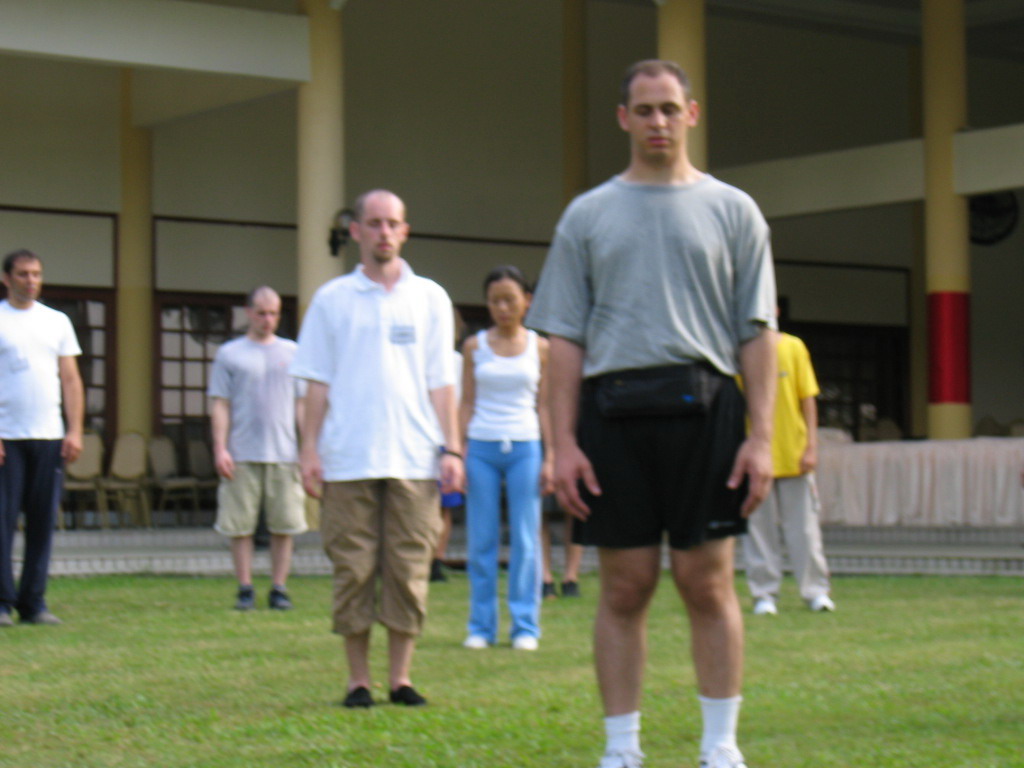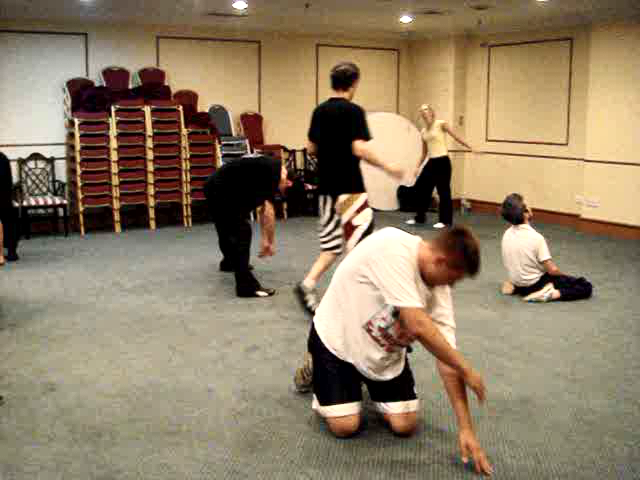SELECTION OF QUESTIONS AND ANSWERS
FEBRUARY 2013 PART 2

Standing Meditation
Question 1
A great Austrian film showed interviews with various spiritual teachers and scientists all over the world. It was great to see a lot of what I learned from you and felt in practice, especially the interconnectedness of everything in the universe, confirmed again by various people.
— Sifu Leo, Austria
Answer
We are very fortunate to inherit a great tradition. Our school, Shaolin Wahnam, was founded to preserve this great tradition and spread its wonderful benefits to deserving people irrespective of race, culture and religion.
Editorial Note
: Sifu Leo's other questions are found at
February 2013 Part 1
issue of the Question-answer Series.
Question 2
Many of them see a collective shift in consciousness, a worldwide spiritual awakening, going on already. I believe that change is omnipresent, but the film (like different sources before) suggests that an extensive and dramatic transformation is happening.
I never believed that the world would end with the Mayan calendar this December, but I can imagine that the beginning of the next circle could be the start of something amazing. I see more and more people searching for spirituality again in Western society. Do you also have the feeling of a wide-spread advancement of consciousness?
Answer
While it is true that many people in the West believe that the world is experiencing a new surge of spirituality, personally my feeling is different. This is probably because I am rooted in Eastern tradition, which has a strong foundation of spirituality.
I view the surge of spiritual awareness in the West not as a global rise but as a cycle. It balances the comparative decline of spirituality in the East.
Spiritual awareness and economic growth operates in circles. India and China had their golden age of economy and culture at a time when Europe experienced a dark age, and America was still unknown. This was followed by spiritual awakening in the East, while the West struggled towards economic growth.
Then the West became prosperous while the East declined in economic wealth. When people in the West became comfortable, they aim at spiritual growth, while people in the East paid attention to economic recovery rather than spiritual development. We are now at this stage.
At present there is talk about economic collapse in the West. I believe this is not true. I believe the present difficult economic situation in the West is just a dip and not a drop, and the West will recover its economic glory. Should it be a drop, then its present spiritual awareness will be short-lived.
The film you mentioned deals with the awareness that there is no ego, no separateness and how to live an awakened life. So it is obviously inspired by Buddhism. The present spiritual awareness in the West is indeed inspired by Buddhism.
Yet, all the world great religions teach awareness with no ego, no separateness and how to live an awakened life. All the world religions actually teach the same Truth, but due to differences in history, culture, language and other factors, most of their followers interpret the same Truth differently.

Flowingly Still
Question 3
There were two major thoughts remaining in my mind after watching the film. Judging brings separateness.
Our mind is constantly judging other people, ourselves and our environment. I guess the Zen method to stop judging is to simply stop judging, but can you recommend any other methods that might be easier at the beginning?
Answer
I believe that the saying "not to judge other people" has become a fashion, and is often taken blindly. In other words, many people today, in their effort to be politically right, often advice not to judge other people, without actually realizing what they mean.
In my opinion, it is necessary to make judgment, but of course we have to judge fairly and wisely. We have to judge, for example, whether the persons we associate with are sincere, whether the art we practice brings benefit, and whether the actions we take are right and noble. Just associating with any persons, or practicing any art or taking any actions without judgment is silly.
The advice of not judging is often related to the concept of no ego. It has also become a fashion for many people to talk of eliminating the ego without actually knowing what they mean.
The ego is necessary. Without ego, a person has no identity. He also has no personality, and no character. Just as a soul, while still being housed in a body, needs the body for cultivation, a person needs his ego to identify himself.
It is when his ego has become bigger than what it actually is, like when he has become arrogant or inconsiderate, that he needs to curb his ego. If his ego is wholesome and honourable, it becomes an inspiration for others to follow.
Question 4
When you start to observe your thoughts instead of following them blindly you can free yourself from the "monkey mind". Our meditation aims at a one-pointed mind at the beginning and later at no-mind. I never found the expression of "observing your thoughts" in Wahnam, although I read about it in several other sources. Is our method the Zen short cut?
Answer
There are many ways to tame the "monkey mind". While "observing your thoughts" is effective for many other people, we normally do not use it in our school because we have other effective methods which have been proven to be very useful.
Using our methods, which employ attaining a one-pointed mind and expanding to no-mind, we have achieve in a very short time results that many people consider miraculous, like expanding the spirit beyond the physical body, and being nowhere and everywhere.
We do not call our methods a short-cut of Zen, as Zen itself is the fastest method. Observing their own thoughts may be the Zen method for other people, but attaining a one-pointed mind and expanding to no-mind are our Zen methods.
The Venerable Hui Neng, the Sixth Patriarch, did not approve of observing ones thoughts, because this method may generate thoughts. He advocated attaining no-mind, which is all mind.

Swaying Willows
Question 5
Please advise me about students teaching under their instructors. I wish to open a school in Edinburgh and visit it once a month and have my students run the classes while I am not there.
— Sifu Mark Appleford, Chief Instructor of Shaolin Wahnam UK
Answer
If he (or she) is teaching a class of more than 20 students, with or without you supervising, we can confirm him as a certified instructor if I am satisfied that he qualifies. Please give me his brief Shaolin Wahnam history.
He should have attended at least one intensive course of the art he is going to teach, which would give him some depth in the art. The most important qualification is that he is of good character and practices the Ten Shaolin Laws.
Question 6
I would also like to know about appointing students as assistant instructors.
Answer
This is usually between you and them, but bear in mind that assistant instructors are likely to be instructors in due time. It would not be pleasant feeling for them if someone else is made an instructor in their region instead of them.

Self-Manifested Chi Movement
Question 7
Sifu, you also mentioned having an assistant to help with chi kung healing, especially the year long programme.
Answer
This is a paid assistant who may or may not be a member of our school. His main job is to see that your patients attend your prescribed healing session everyday even when you may not be present.
You should have at least 5 patients who have paid you the complete fees before you start employing one, or start renting a place for healing.
Question 8
Could you please confirm that the following 5 Levels of Chi Flow is correct? Could you explain the five levels and their different aspects for health and vitality generally?
Standing Meditation
Flowingly Still
Gentle Breeze Swaying Willows
Flowing Water Floating Clouds
Self Manifested Chi Movement
Answer
Yes, this is correct.
Very briefly and generally, standing meditation is standing still, and is for spiritual cultivation.
Flowingly still is for developing internal force and mental clarity.
Flowing Breeze Swaying Willows, Flowing Water Floating Clouds and Self-Manifested Chi Movement, which represents progressive levels of chi flow and bodily movement in ascending order, are for healing.
Usually but not always, the progression is as follows. Those who are old, serious sick and new in chi kung treatment start with little chi flow and small bodily movement in Flowing Breeze Swaying Willows. As they improve, they progress to more chi flow and bodily movement in Flowing Water Floating Clouds and Self-Manifested Chi Movement.
When they have recovered from their illness, irrespective of whether they are young or old, as they continue to practice for vitality and longevity as well as peak performance and spiritual fulfilment, the chi flow and bodily movement are reverse, i.e. from Self-Manifested Chi Movement to Flowing Water Floating Clouds to Flowing Breeze Swaying Willows, and eventually to Flowingly Still and Standing Meditation.
So it is a cycle. First there is little chi flow and bodily movement, then the flow and movement increase until they are vigorous. Then they gradually slow down to be quite still.
The initial stillness and the eventual stillness are different. Initially patients or students are still because they are tensed and have little energy. Eventually they are still because there is no blockage so that their energy, which is tremendous, flows smoothly.
This description is general; there may be exceptions.
LINKS
Selected Reading
- Is it not True that there is Only One Truth and One God?
- Shaolin Kungfu Now and 500 Years Ago
- How Not to Be Out of Breath After Hours of Sparring
- Attaining Marvelous Feats in Sinew Metamorphosis
- Some Examples of Remarkable Recovery
